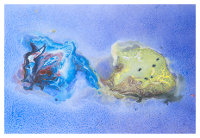Speaker
Dr
Alexander Rothkopf
(Institute for Theoretical Physics, Heidelberg University, Heidelberg, Germany)
Description
We present the results of a recent study on the in-medium modification of the spectral properties of Bottomonium S-wave (\Upsilon) and P-wave (\chi_b1) states. The light degrees of freedom of the surrounding medium are represented by 48^3x12 HotQCD lattices with Nf=2+1 HISQ flavors, which span the temperature range 140.40(MeV)(= 0.911T_C) < T < 248.63(MeV)(= 1.614T_C). The heavy quarks on the other hand are treated as probes, evolving in the background of the medium fields according to non-relativistic QCD (NRQCD) .
Spectral functions are extracted from the NRQCD propagators using a novel Bayesian approach, which is contrasted to the standard Maximum Entropy method. We confirm the finding of previous studies that \Upsilon retains a well defined peak structure even at 1.6TC. Inspection of its mass reveal that medium effects only begin to play a role above T\sim175MeV, while its width appears to grow monotonously. For \chi_b1 we find that with the new Bayesian method, it is possible to resolve a ground state peak also up to T=248.6MeV, contrary to the MEM, which suggests ground state melting already at T>205MeV.
Authors
Dr
Alexander Rothkopf
(Institute for Theoretical Physics, Heidelberg University, Heidelberg, Germany)
Dr
Peter Petreczky
(Brookhaven National Laboratory - Department of Physics, Upton, USA)
Prof.
Seyong Kim
(Sejong University - Department of Physics, Seoul, South Korea)
